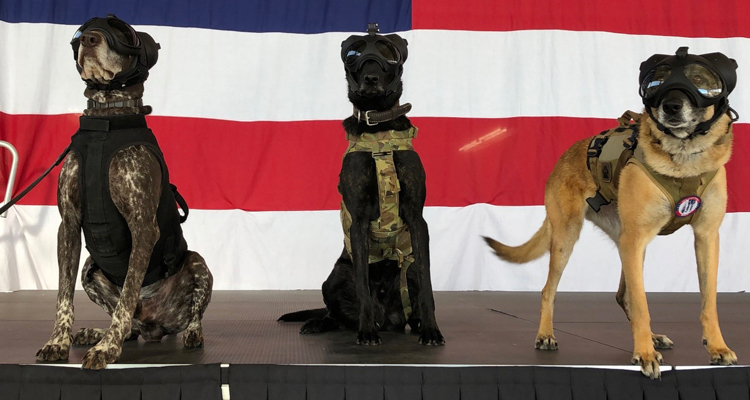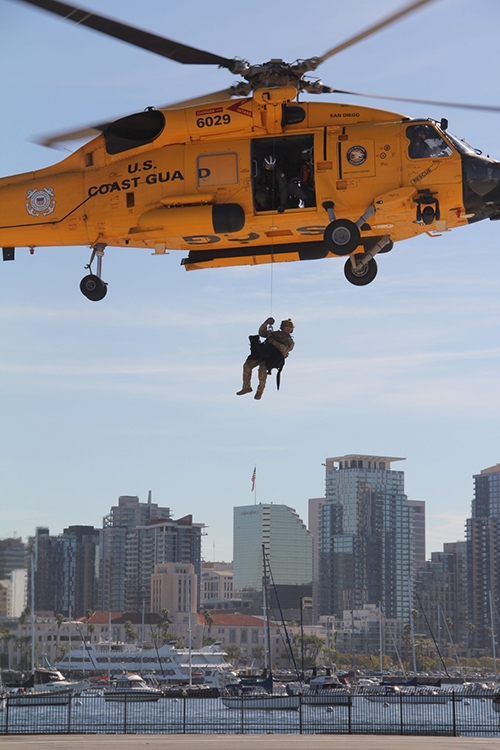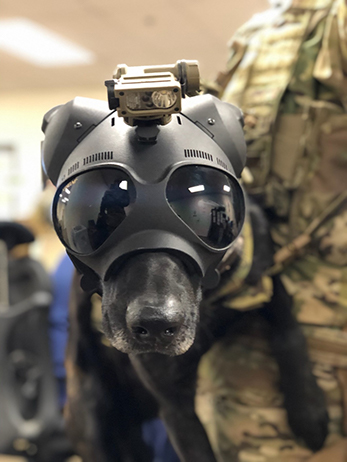June 5, 2020 —

The Coast Guard’s Research and Development Center is working with K-9 units from Maritime Security Response Team West to find high-quality safety equipment for K-9s across the service. From left, K-9 Bingo, K-9 Wrangler and K-9 Sonya show off updated harnesses and helmets. U.S. Coast Guard photo by Petty Officer 2nd Class Christopher Hartman.
What do the Super Bowl, presidential inaugurations and maritime mass transit have in common? Coast Guard K-9 units on duty to serve and protect.
While the Coast Guard’s K-9 units are stationed at major ports with a primary focus on maritime mass transit, their expertise in explosives detection makes them uniquely suited to provide security for high-profile and high-attendance events. These missions carry great risk for both handlers and dogs, so high-quality safety equipment is paramount. The Coast Guard’s Research and Development Center (RDC) recently completed testing on commercially available safety equipment for K-9s as part of a project to seek out better protection options.

Once the dogs have acclimated to the safety equipment on the ground, the handlers and their K-9 partners take turns hoisting to and from an MH-60 Jayhawk helicopter. Video of the hoist tests is available here. U.S. Coast Guard photo by Petty Officer 1st Class Christopher Hartman.
A unique asset for a unique range of missions
K-9 units have been part of the Coast Guard for the past 70 years. Though originally involved in ports, waterways and coastal security missions on land and aboard ships, they have specialized in explosives detection since the events of 9/11. The Coast Guard currently has 18 billets for K-9s across the service who execute a wide array of missions on land and sea.
Their land-based missions can range from bomb threat response and sweeping crowds at highly attended and high-profile events to providing security details for the president of the United States, cabinet-level or high-ranking military officials or foreign dignitaries. For example, the service’s K-9s provided security at the 2020 Super Bowl – where they conducted sweeps for explosives to verify the safety of thousands of spectators.
Though a number of dogs are trained through the Transportation Security Administration explosive detection program, the Coast Guard’s K-9s are uniquely trained to deploy via helicopter or boat to execute missions at sea. For example, if the Coast Guard becomes aware of a threat aboard a ship, a K-9 unit can be deployed via helicopter to intercept the ship miles off shore. This unique training makes the K-9s the Coast Guard’s only operational real-time detection tool and best asset for sweeping large areas or crowds for explosives in a minimal amount of time.
The nature of the K-9 missions is inherently dangerous. Both humans and dogs are exposed to situations where potential live bombs could be present and work environments with loud noises, debris and other hazards; they also are hoisted via harnesses between Coast Guard helicopters and boats and other vessels. While the humans facing these dangers have a variety of personal protective equipment at their disposal, the K-9s require special equipment to fit their anatomy.

Petty Officer 1st Class James Grant and K-9 Sonya demonstrate a hoist harness for member of the RDC’s Science and Technology Innovation Center (STIC) during operational testing in San Diego, California. The STIC team is investigating hoist harnesses that provide better spinal support to prevent long-term spinal injuries. U.S. Coast Guard photo by Lauren Eberly.
Dressing for success could be life or death
This project is a good example of the need for flexibility and quick response to emerging research and development needs within the Coast Guard. The Science and Technology Innovation Center (STIC) was established at the RDC to respond to just such emerging needs, said Lauren Eberly, STIC principle investigator.
The project began with a number of conversations about the requirements to improve K-9 safety between the STIC team and Petty Officer 2nd Class James Botticelli, a K-9 handler stationed at Maritime Security Response Team West. From these conversations, the STIC team learned that the dogs need ear and eye protection to prevent sounds and debris from causing injuries. Unfortunately, the dogs tend to find goggles and earmuffs uncomfortable, leading them to knock or paw the protective gear off their heads. So one critical element of the project was finding helmets that are molded to the dogs’ anatomy so they could not be easily dislodged by the K-9s. The STIC team also learned about the safety considerations for hoisting operations and the need for harnesses that provide better spinal support to prevent long-term spinal injuries.
Armed with this knowledge, the STIC team “did a broad sweep of commercially available products for tactical K-9s to find products we felt would fill the needs gap of the Maritime Safety and Security Teams,” Eberly explained. “We sourced the gear from companies which outfit firefighting, police, military and security dogs – and even a company which makes products for people who rock climb with their dogs.” After discussing their choices with Botticelli, the team acquired a number of harnesses, ballistic vests and helmets for a field evaluation in San Diego, California.
“We spent two days observing the K-9 units as they hoisted and conducted practice search missions,” Eberly said. “In addition to new hoist harnesses and helmets, we evaluated modular ballistic and stab-proof overlays (vests) that the handlers can place and remove quickly based on threat level, a harness attachment that allows the handlers to strap their K-9s to their backs for quick extraction, and 360-degree live streaming cameras that were attached to the dogs’ helmets to allow the handlers to remotely view the K-9s’ movements for both training and live mission use.”
The STIC team expected some challenges in working for a customer who can’t directly communicate its needs, but researchers found that the handlers are so in tune with their dogs that they could speak for them and explain their behaviors. The strong bond between the dogs and their handlers played an integral role in training the dogs on the new equipment. With their help, the process took only a day.
The dogs were eased into the new gear by first wearing the helmets without the lenses or ear protection. Upon introducing new components, such as adding clear and shaded lenses, the handlers played catch or ran training exercises with the dogs to ease them into the visual changes caused by the lenses. When trying out the harnesses and vests, the dogs were given ample time to acclimate to them on the ground prior to testing hoisting situations. “Repetition and acclimation are key, so that when the K-9s are conducting missions, they can focus on the threat at hand and not on any new gear,” Eberly explained.
An investment worth protecting
The ultimate goal of the project is to recommend standard high-quality protective equipment for all K-9s in the Coast Guard. Each dog represents an investment of more than $100,000 by the Coast Guard and provides a priceless service. High-quality protective equipment reduces the likelihood that a preventable injury will lead to a K-9’s early retirement from service, enabling the Coast Guard to benefit from that investment as long as possible.
The handlers have always done their best to stay on top of new technology for protecting their dogs. Now that they can rely on the RDC to conduct market research, meet with vendors, test and evaluate products, validate field readiness, and provide a recommendation on standard protective equipment, the handlers and their dogs are able to keep their focus where it belongs – successful mission execution.
For more information: Research and Development Center program page and Research, Development, Test and Evaluation program page

K-9 Wrangler tests a helmet with a flashlight attachment. U.S. Coast Guard photo by Petty Officer 1st Class Christopher Hartman.